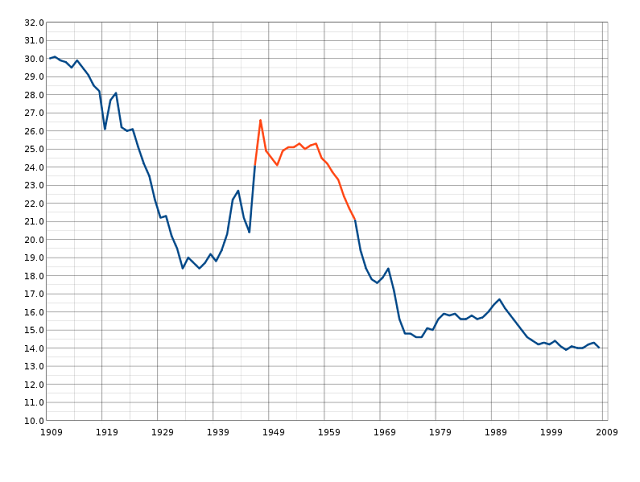The Gray Depression
In the next few years, the average age of the US population is going to start drastically increasing. By 2025, the population of people over 65 will almost double in the United States, while the population of working-age adults and children will only rise by about 15%. Clearly, since the older-aged population is growing faster than the middle-aged and youngsters, the American population’s average age will rise. The reason that the growth rate of the older population is so high is because the first of the people born in the baby boomer era have just begun retiring and will continue to do so until 2029. The baby boomers were people born after World War II, in the years 1946 to 1964 (marked in red on the graph below). These years were marked by high post-war birth rates, and now, 65 years later, they are aging and perhaps also taking a toll on the US economy, which is just now getting back on track.
The graying of the US population has serious implications on the economy. As a person ages, naturally, their body starts to deteriorate and they require more care. Now, with all these people aging at once, the combined increase in payments to Social Security and Medicare can be pretty significant for the economy as a whole. One of the most common diseases associated with old-age is Alzheimer’s disease. Currently, there are 5.4 million Americans who suffer from this disease, with payments for their care estimated at around $200 billion. By the end of 2025, there could be more than 15 million people with the disease. The aging population will strain the national healthcare system, and it could be argued that combined with Obama’s Affordable Health Care Act, our healthcare system can get severely crippled.
Historically, the biggest spenders in our economy are middle-aged adults from ages 45 to 54. This is because they are working in the prime of their career, usually making peak earnings, and they have a lot of expenditures at that point in their life. When you’re younger, you might not by a house or car that is high-end, but when you’re nearing retirement and you’re making the most money you’ve ever made, you’ll be feeling wealthier, which increases consumption, and thus most spending in a person’s lifetime happens in this age range. At this stage in a person’s life, they may have to finance their children through college, pay off their biggest mortgage, and make payments on their best car. Currently, we have more people in this age range than ever before because all the baby boomers have aged. Extending this, in about 10 years, after baby boomers have grayed even more past that age range, we are going to have a shockingly low amount of people from ages 45 to 54. This could severely depress our economy because the majority of spending comes from people ages 45 to 54, so when the proportion of those people decreases and the proportion of people ages 65+ increases at the same time, the economy is losing out on its biggest source of consumer spending, while having to financially support another group of people, through Social Security and Medicare. The aging of this big part of our economy could have negative implications in the near future, which is bad news for a recovering economy.
-Yashwant Chunduru
-Yashwant Chunduru


Comments
Post a Comment